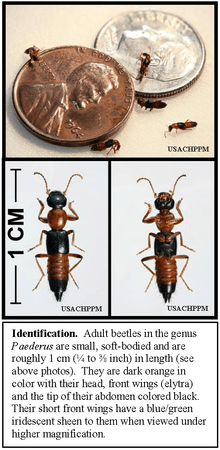Paederus dermatitis


Paederus dermatitis (also called linear dermatitis or dermatitis linearis) is skin irritation resulting from contact with the hemolymph of certain rove beetles, a group that includes the genus Paederus.[1][2] Other local names given to Paederus dermatitis include spider-lick, whiplash dermatitis,[3] and Nairobi fly dermatitis.[1]
The active agent is commonly referred to as pederin, although depending on the beetle species it may be one of several similar molecules including pederone and pseudopederin.[4]
"Blister beetle dermatitis," a term more properly used for the different dermatitis caused by cantharidin from blister beetles, is also sometimes used to describe paederus dermatitis caused by rove beetles.[5][6]
Diagnosis and treatment
Once pederin is on the skin from the initial beetle contact, it may also be spread elsewhere on the skin. "Kissing" or "mirror-image" lesions where two skin areas come in contact (for example, the elbow flexure) are often seen.[5] Washing the hands and skin with soap and water is strongly recommended, if contact with a rove beetle has occurred.[7]
Initial skin contact with pederin shows no immediate result. Within 12–36 hours, however, a reddish rash (erythema) appears, which develops into blisters. Irritation, including crusting and scaling, may last from two to three weeks.[7]
One study reported best results with a treatment regimen that combined topical steroids with oral antihistamines and antibiotics. The authors hypothesized that antibiotics were helpful because of the possible contamination of skin by pederin-producing bacteria.[8]
Location and species
Three different genera of rove beetles, all members of the same subtribe Paederina, can cause paederus dermatitis: Paederus, Paederidus, and Megalopaederus.[9] This irritant is called pederin and is highly toxic, more potent than cobra venom.[10]
In different parts of the world, different species of rove beetle cause Paederus dermatitis:
- Paederus melampus, also known as the Manipal bug or Nitte Police, occurs in the Indian state of Karnataka. (Manipal is the name of a university town.) In a 2007 article titled 'Paederus Dermatitis', two dermatologists from Sri Devaraj Medical College in Karnataka identified the Manipal bug as Paederus melampus. They are also sometimes called "blister beetle", although rove beetles such as P. melampus are in a different Family (biology) family (Staphylinidae) than the blister beetle family Meloidae.[5]
- Paederus brasilensis, also called "El podo," causes dermatitis in South America. There is also a Venezuelan species, Paederus columbinus.[5]
- Paederus fuscipes is probably the major agent that causes linear dermatitis in northern Iran. Whereas this disease is a rural difficulty in the south, mainly in villages or small towns, it is an urban problem in northern provinces along the Caspian Sea shore.[11] The same species also causes linear dermatitis in Taiwan.[12]
- Paederus australis is responsible for outbreaks of dermatitis in Queensland and the Northern Territory, and Paederus cruenticollis for outbreaks in southern New South Wales.[13]
- Nairobi fly: Paederus crebrepunctatus and Paederus sabaeus both cause dermatitis in East Africa.[14]
Paederus dermatitis has also been reported from Nigeria[15] France, Okinawa, Australia, Malaysia, Indonesia, Thailand, Singapore, Taiwan, India, Vietnam (Perumbavoor, Kerala) and Sri Lanka.
See also
- Amebiasis cutis
- Anotylus tetracarinatus, a related beetle that causes severe pain when caught in the eye
- Blister beetle dermatitis
- List of cutaneous conditions
- Carpet Beetle
References
- 1 2 Rapini, Ronald P.; Bolognia, Jean L.; Jorizzo, Joseph L. (2007). Dermatology: 2-Volume Set. St. Louis: Mosby. ISBN 1-4160-2999-0.
- ↑ http://www.springerlink.com/content/qg286001k0066710/
- ↑ Mullen, Gary; Gary Richard Mullen, Lance Durden (2009). Medical and Veterinary Entomology. Academic Press. p. 102. Retrieved 31 July 2011.
Pederin contacts human skin only when a beetle is brushed vigorously over the skin or crushed.
- ↑ Verma, Rajesh; Sunil Agarwal (2006). "Blistering beetle dermatitis: An outbreak" (PDF). Medical Journal Armed Forces India. 62 (1): 42–44. doi:10.1016/s0377-1237(06)80154-1. Retrieved 28 July 2011.
- 1 2 3 4 Singh, Gurcharan; Syed Yousuf Ali (2007). "Paederus dermatitis". Indian Journal of Dermatology, Venereology and Leprology. 73 (1): 13–15. doi:10.4103/0378-6323.30644. Retrieved 21 March 2014.
- ↑ "Blister Beetles". Institute of Tropical Medicine. Retrieved 27 July 2011.
- 1 2 "Just the facts…Paederus Beetles" (PDF). US Army Public Health Command. Retrieved 30 July 2011.
- ↑ Qadir, Syed Nurul Rasool; Naeem Raza, Simeen Ber Rahman (2006). "Volume 12 Number 7 Paederus dermatitis In Sierra Leone". Dermatology Online Journal. 12 (7): 9. Retrieved 3 August 2011.
- ↑ Capinera, John L; J. Howard Frank (2008). "Dermatitis linearis". Encyclopedia of entomology. Springer. pp. 1179–. ISBN 978-1-4020-6242-1.
The 28 species thus far shown to produce such a toxin belong to three of the 14 genera of Paederina, namely Paederus, Paederidus, and Megalopaederus
- ↑ "Ectoparasites". Institute of Tropical Medicine, Antwerp. Retrieved 2007-06-04.
- ↑ Nikbakhtzadeh, M.R.; S. Tirgari (2007). "Medically important beetles (insecta: coleoptera) of Iran" (PDF). J. venom. anim. toxins incl. trop. dis. 14 (4): 597–618. doi:10.1590/s1678-91992008000400004. Retrieved 3 August 2011.
- ↑ Journal of Dermatology, May 31. 2007
- ↑ Sutherland, Struan K.; Tibballs, James (2001) [1983]. Australian Animal Toxins (2nd ed.). South Melbourne, Victoria: Oxford University Press. p. 514. ISBN 0-19-550643-X.
- ↑ 'Beware, the Nairobi fly is back in town', The Nation, 5/27/2007
- ↑ The Internet Journal of Tropical Medicine. 2006 Volume 3 Number 1